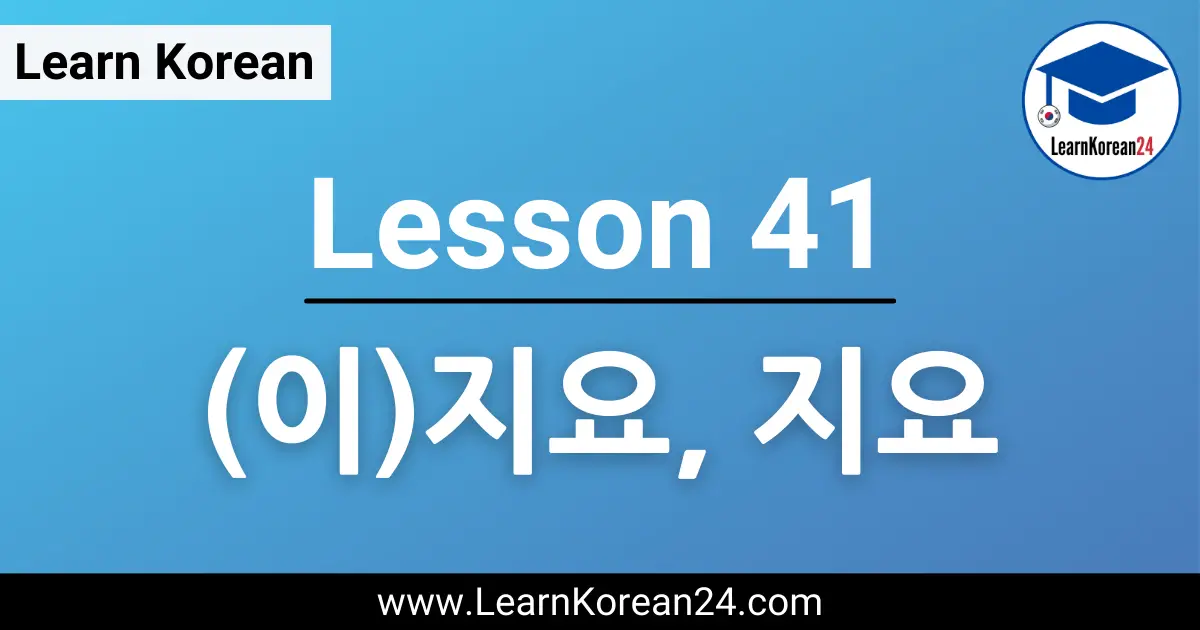Lesson 41: (이)지요, 지요
Welcome to Level 3 of our online Korean language course. Congratulations on making it this far! In this lesson, you will learn the meaning of (이)지요 and 지요. (이)지요 and 지요 are two ways to say “~ isn’t it/she/he?” or “don’t you?“. These are similar to ‘question tags’ in English. (이)지요 and 지요 are used when you are confirming something that the listener already knew. By the end of this lesson, you’ll be able to say things like “This is delicious, isn’t it?”, “You’re Korean, aren’t you?”, “You met your friend yesterday, didn’t you?”, etc.
Lesson 41: (이)지요 and 지요
(이)지요
(이)지요 is an ending that means “~ isn’t it/she/he?” or “~ aren’t you/they?“. It is often used in questions to confirm something that the listener already knew or to seek for the listener’s agreement. (이)지요 is attached only to nouns. In a casual, non-polite sentence, (이)지 is used without the polite ending 요.
| Conjugation Rule | Examples |
|---|---|
| Noun Ending In Consonant + 이지요 | 학생 (student) → 학생이지요 |
| Noun Ending In Vowel + 지요 | 친구 (friend) → 친구지요 |
Example Sentences
한국 사람이지요? = You are Korean, aren’t you?
오늘이 금요일이지요? = Today is Friday, isn’t it?
마이클 씨는 요리사지요? = Michael is a chef, isn’t he?
거기 수민 씨 집이지요? = This is Sumin’s house, right? (phone call)
저 사람은 친구지? = That person over there is your friend, isn’t she? (casual)
지요
지요 is an ending that means “~ doesn’t it/she/he?” or “~ don’t you/they?”. It is often used in questions to confirm something that the listener already knew or to seek for the listener’s agreement. 지요 is attached only to verbs and adjectives. In a casual, non-polite sentence, 지 is used without the polite ending 요. There are no special conjugation rules with 지요. Simply attach it to the first verb/adjective without a space. Let’s look at some examples.
Examples
가다 = to go (Verb)
가지요? = You go, don’t you?
먹다 = to eat (Verb)
먹지요? = You eat, don’t you?
공부하다 = to study (Verb)
공부하지요? = You study, don’t you?
크다 = to be big (Adjective)
크지요? = It’s big, isn’t it?
작다 = to be small (Adjective)
작지요? = It’s small, isn’t it?
맛있다 = to be delicious (Adjective)
맛있지요? = It’s delicious, isn’t it?
아니다 = to be not (Adjective)
아니지요? = It’s not, is it?
Using 지요 In Different Tenses
When using 지요 in different tenses, you simply combine the ending 지요 with the standard tense conjugation. See the table below for examples.
| Conjugation Rule | Examples |
|---|---|
| Present Tense : Verb /Adjective Stem + 지요 | 먹다 (to eat) → 먹지요? 작다 (to be small) → 작지요? |
| Past Tense: Verb /Adjective Stem + 았/었지요 | 먹다 (to eat) → 먹었지요? 작다 (to be small) → 작았지요? |
| Future Tense: Verb /Adjective Stem + (으)ㄹ 거지요 | 먹다 (to eat) → 먹을 거지요? 작다 (to be small) → 작을 거지요? |
(이)지요 Vs 지요
Both (이)지요 and 지요 are used in questions to confirm something that the listener already knew or to seek for the listener’s agreement. The difference between these two is that (이)지요 is used with nouns only, whereas 지요 is used with verbs and adjectives. To help you understand what we mean, check out the following two sentences:
- 이거는 한국어 책이지요? = This is a Korean book, isn’t it?
- 한국어 책을 읽지요? = You are reading a Korean book, aren’t you?
As you can see, in the first sentence, 이지요 is attached to the noun 책 (book), and in the second sentence, 지요 is attached to the verb 읽다 (to read).
Example Sentences
오늘이 금요일이지요? = Today is Friday, isn’t it?
맞아요. = That’s right.
저 사람은 친구지? = That person over there is your friend, isn’t she?
아니. 동생이야. = No. She’s my younger sister.
이거 맛있죠? * = This is delicious, isn’t it?
네, 진짜 맛있어요! = Yes, it really is.
요즘 한국어를 배우지요? = You’re learning Korean these days, aren’t you?
네. 그런데 조금 어려워요. = Yes. But it’s a little difficult.
저거 살 거죠? *= You are going to buy that, aren’t you?
글쎄요. 좀 비싸네요. = Erm…Not sure. It is quite expensive.
오늘 백화점에 사람이 많았지요? = Today there were a lot of people at the department store, weren’t there?
네. 정말 많았어요! = Yes, there were so many!
*지요 is often shortened to 죠 in real conversation.


